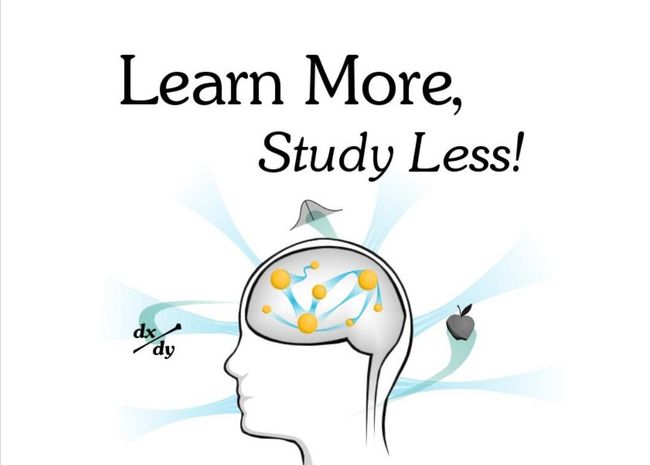整体性学习的顺序 The Sequence of HolisticLearning
The sequence of holistic learning is:
1) Acquire
2) Understand
3) Explore
4) Debug
5) Apply
6)Test
1)Acquire- The point at which information enters through your eyes and ears.
Reading, taking notes in a class or personal experiences are all part of the Acquire Phase.
The goal here is to get accurate information in the most compressed form.
所有进入你眼睛和耳朵里的信息,都发生在这个获取阶段。要保证获取到的信息是压缩的精确信息
When acquiring information, you have three major goals:
获取信息阶段的三个目标
Simplicity简化
Reading requires that you consume the purest information possible.
Simplicity means you acquire the information with the lowest amount ofredundancy.
Volume容量
As long as you account for(理解)simplicity, your should be trying to get the mostinformation possible.
Reading one sentence from this book offers far less understandingthan reading every page.
The more information you can process, the more you willunderstand.
Someone who reads a 100 books a year will usually have more knowledgethan someone who reads only 2 or 3.
Speed速度
The final goal of acquiring information is speed.
All things being equal, reading abook in thirty minutes is better than taking an hour.
Speed tends to work againstvolume and simplicity.
The faster you go, generally the less information you can absorband the less discriminating you can be
in determining what to acquire.
通过采用更好的方法是可以提高获取阶段获取信息的质量的。
The Acquire Phase can be enhanced by adopting better reading and listening methods.
Even at this early stage, most people have significant room for improvements.
2) Understand- Understanding means taking raw information and giving it acontext.
This would be the most basic interlinking you would need to perform in orderto learn.
理解阶段意味着你要把吸收到的原始信息放在文本中进行理解,这是你需要做的最基本的联系。
The Understand Phase
没有理解就无法应付学习和生活上的难题
Input is nothing without comprehension.
If you don’t understand the surface of what a book is trying to say,
the chances of remembering it for an exam or applying it in real life are almost nonexistent.
As an example, say you are learning a new mathematical formula.
You know the basics of what the symbols in the formula stand for,
and possible problems that could be solvedusing this formula.
If you repeat the formula enough times, you might even rememberit.
Learning by rote is learning with only the Understand Phase.
但是仅有理解是不够的,因为理解只是最基本的联系。
The Understand Phase, is where most people stop and smart people go beyond.
Simply reaching this phase shows that you have linked the information enough
so you can understand the context.
The formula isn’t just random squiggles and letters.
Unfortunately, it isn’t much more.
You might not be able to determine how the formula was derived,
how it relates to other formulas
or how it can be applied to problems outside what you’ve been taught.
3) Explore - The Explore Phase is really where holistic learning takes full force.
Here you form the models, highways and broader connections needed for well definedconstructs.
探索阶段阶段是是整体学习最需要出全力的地方,在这个阶段能够形成知识模型,知识高速公路以及知识结构所需的更广的联系
探索阶段才是整体性学习的开始
A holistic learner would take the formula I mentioned in the last phase, and explore it.
Where does it come from?
What do the different components of the formula represent?
What elements of the formula can be altered and how does that change results?
What other formulas are similar to this in function or form?
There are three major ways you can explore ideas: depth, lateral and vertical exploration.
Depth Exploration 深度探索——追本溯源
数学公式来自哪里,一个发现是如何做出的,为什么事物以这种方式存在。
Information comes from somewhere.
Where does a formula come from?
How wasa discovery made?
Why are things the way they are?
Depth exploration requires that you create links into information.
Instead of just understanding a formula, you understand its proof.
You understand why the proof was developed and by whom.
Now, through depth exploration, your formula becomes
supported underneath a foundation of other linked ideas.
理解一个公式背后的证明,证据
Lateral Exploration 横向探索——诸如此类
信息不会孤立存在,有那些与此相似的东西?
Information doesn’t stand alone.
What formulas are similar to this one in function or design?
What other discoveries were made at the same time,
by the same person or in the same field?
What other facts surround this one?
Vertical Exploration 纵向探索——寻求比喻
知识信息都遵循一定的模型,这种模型能在其他的知识领域中找到吗?
Information follows patterns, those patterns can be found in other information.
Can I compare this formula to a natural event, like water flowing or driving a car?
How does this discovery relate to a completely different historical event?
How is this ideasimilar to completely different ideas.
4) Debug - The Debug Phase looks for errors in your models and highways.
This phase prunes back your connections so invalid ones won’t remain,
or will beconstrained to the area they work.
纠错阶段寻找知识模型和知识高速公路上的错误。
Learning is not error free.
The problem with interlinking, is that a wrongconnection can createfalse understandings.
This happens when you believe youunderstand an idea,
but therelationship it is based on is faulty.
学习不可能不犯错,错误的联系会导致错误的理解。
5) Apply - Having a set of understandings is useless
if they aren’t tailored to the real world.
Failure on this step could be an example of people
who have book-smarts but can’t seem to use them outside the class.
如果不能应用于现实世界,再多的理解也是没用的。
Application is where learning becomes complete.
Being able to apply information makes it more likely to match the real world.
You would learn tax law better if you had to apply it to your own business
than just hypothetical examples.
You wouldunderstand statistics better if you designed your own experiments.
应用是学习的最终阶段。应用会让学习效果更好。
6)Test - Continuously you should be testing your methods and learningthroughout all six stages.
This will help you quickly identify problems in the systemyou use for learning,
and help youdevelop new techniques to combat weaknesses.
上述的每一步都需要测试。那样会有助于你确定问题,发展新技能,克服缺点。
